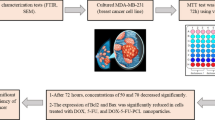Summary
The aim of this study was to evaluate the feasibility and efficacy of using TRAIL gene to treat breast cancer mediated with a novel carrier — magnetic iron oxide nanoparticles (polyMAG-1000) coated with PEI. The magnetic iron oxide nanoparticles were used as gene carrier to transfect TRAIL gene into MCF-7 cells. The polyMAG-1000 without TRAIL gene was transfected into the tumor cells as negative control. TRAIL gene transfection with liposome as carrier served as positive control. The apoptosis of cells was detected with TUNEL method. The apoptosis ratio of tumor cells was measured with flow cytometry (FCM). It was found that the apoptosis occurred in the tumor cells after transfection of TRAIL gene mediated by both polyMAG-1000 and liposome. The apoptosis ratio in the group with polyMAG-1000 as gene carrier was (25.11 ± 2.85) %, whereas it was (5.06 ± 1.05) % in the control group with polyMAG-1000 (P<0.01). The apoptosis ratio was as low as (18.31 ± 2.44) % in the group with liposome as gene carrier (P<0.05, as compared with the group with polyMAG-1000 as gene carrier). It is suggested that TRAIL gene may induce apoptosis in MCF-7 breast cancer cells. The magnetic iron oxide nanoparticles coated with PEI may be a potential gene carrier with high transfection efficacy for cancer gene therapy.
Similar content being viewed by others
References
Wang S, El-Deiry W S. TRAIL and apoptosis induction by TNF-family death receptors. Oncogene, 2003,22(53):8628–8633
Seol J Y, Park K H, Hwang C I. Adenovirus-TRAIL can overcome TRAIL resistance and induce a bystander effect. Cancer Gene Ther, 2003,10(7):540–548
Thomas M, Klibanov A M. Non-viral gene therapy: polycation-mediated DNA delivery. Appl Microbiol Biotechnol, 2003,62(1):27–34
LeBlanc H N, Ashkenazi A. Apo2L/TRAIL and its death and decoy receptors. Cell Death Differ, 2003,10(1):66–75
Almasan A, Ashkenazi A. Apo2L/TRAIL: apoptosis signaling, biology, and potential for cancer therapy. Cytokine Growth Factor Rev, 2003,14(3–4):337–348
Lee J, Hampl M, Albert P. Antitumor activity and prolonged expression from a TRAIL-expressing adenoviral vector. Neoplasia, 2002,4(4):312–323
Merdan T, Kopecek J, Kissel T. Prospects for cationic polymers in gene and oligonucleotide therapy against cancer. Adv Drug Deliv Rev, 2002,54(5):715–758
Brokx R, Gariepy J. Peptide-and polymer-based gene delivery vehicles. Methods Mol Med, 2004,90:139–160
Arizono Y, Yoshikawa H, Naganuma H, A mechanism of resistance to TRAIL/Apo2L-induced apoptosis of newly established glioma cell line and sensitisation to TRAIL by genotoxic agents. Br J Cancer, 2003,88(2):298–306.
Author information
Authors and Affiliations
Corresponding author
Additional information
This project was supported by a grant from the National Natural Science Foundation of China (No. 30171062).
Rights and permissions
About this article
Cite this article
Wei, W., Xu, C. & Wu, H. Magnetic iron oxide nanoparticles mediated gene therapy for breast cancer — An In Vitro study. J. Huazhong Univ. Sc. Technol. 26, 728–730 (2006). https://doi.org/10.1007/s11596-006-0628-y
Received:
Issue Date:
DOI: https://doi.org/10.1007/s11596-006-0628-y




